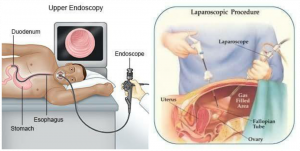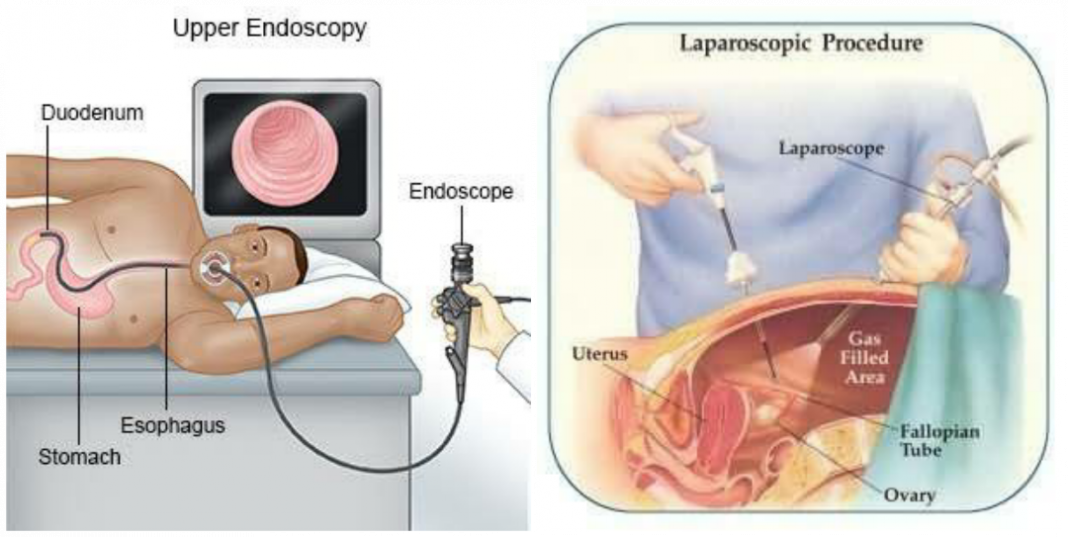Endoscopy Vs Laparoscopy: Difference between endoscopy and laparoscopy
Digestive Tract Diseases, Endoscopy and Laparoscopy: All You Need to Know
I want to talk about laparoscopy and endoscopy today – they are medical devices that help detect digestive tract (Gastrointestinal tract) diseases before they can cause serious problems. They’re sometimes used to to treat life threatening digestive diseases that can cause immediate death.

The purpose of this article is to define as simple as possible what laparoscopy and endoscopy can do, highlight their benefits while at the same time, pointing out the differences between endoscopy and laparoscopy.
I hope that you will find it illuminating and informative read.
Endoscopy
Endoscopy is a nonsurgical procedure used to examine a person’s digestive tract.
Using an endoscope, a flexible tube with a light and camera attached to it, your doctor can view pictures of your digestive tract on a color TV monitor.
During an upper endoscopy, an endoscope is easily passed through the mouth and throat and into the esophagus, allowing the doctor to view the esophagus, stomach, and upper part of the small intestine.
Similarly, endoscopes can be passed into the large intestine (colon) through the rectum to examine this area of the intestine. This procedure is called sigmoidoscopy or colonoscopy depending on how far up the colon is examined.
Benefits of Endoscopy
1. It allows doctors to make a diagnosis.
An endoscopy is used to diagnose conditions that affect the digestive system. Endoscopy can help identify ulcers, bleeding, celiac disease, blockages, inflammation, and tumors. It can help find the cause of unexplained symptoms, such as heartburn, abdonimal pain, bleeding, nausea, vomiting, and pain. An endoscopy is more accurate than gastrointestinal X-rays for detecting abnormal growths such as cancer.
2. An endoscopy is used to treat conditions.
Endoscopy is used to treat digestive tract problems. If certain disorders are found during the procedure, it’s often possible to treat them at the same time.
Your gastroenterologist can pass special tools through the endoscope to treat problems in the patient’s digestive system, such as removing a foreign object, widening a narrow esophagus, or clipping off a polyp.
3. An endoscopy is a safe procedure.
An endoscopy is a safe procedure. It’s considered one of the safest medical procedures and carries a low level of risk. Rare complications include problems with sedation, bleeding, infection, and perforation, though these complications are generally associated with pre-existing conditions.
4. An endoscopy is a quick procedure.
An endoscopy is a quick procedure. An upper endoscopy takes about 20 minutes. You will be awake during the procedure, but you will take medication to relax you (a sedative) before the test. You will remain in the recovery area 30 to 40 minutes after the procedure. Someone will have to drive you home afterward.
5. An endoscopy isn’t usually painful.
An endoscopy is nothing to fear. The procedure is not usually painful, and most patients only experience mild discomfort, similar to a sore throat or indigestion. You may be given local anesthesia to numb a specific area of your body.
It is safe to take acetaminophen for the minor discomfort after the procedure.
Laparoscopy
Laparoscopy is a type of surgery that uses smaller cuts than you might expect.
The process takes its name from the laparoscope, a slender tool that has a tiny video camera and light on the end.
When a surgeon inserts it through a small cut and into your body, they can look at a video monitor and see what’s happening inside you. Without those tools, they’d have to make a much larger opening.
Thanks to special instruments, your surgeon won’t have to reach into your body, either. That also means less cutting.
Benefits of Laparoscopy
Working this way has several advantages compared with traditional surgery. Because it involves less cutting:
You have smaller scars.
You get out of the hospital quicker.
You’ll feel less pain while the scars heal, and they heal quicker.
You get back to your normal activities sooner.
You may have less internal scarring.
Here’s an example. With traditional methods, you might spend a week or more in the hospital for intestinal surgery, and your total recovery might take 4 to 8 weeks.
If you have laparoscopic surgery, you might stay only 2 nights in the hospital and recover in 2 or 3 weeks. And a shorter hospital stay generally costs less.
In conclusion, remember health is wealth. We should all endeavour to stay safe and remain healthy.
Dr Olusegun Olisa, MBChB(Ife), FWACS
























